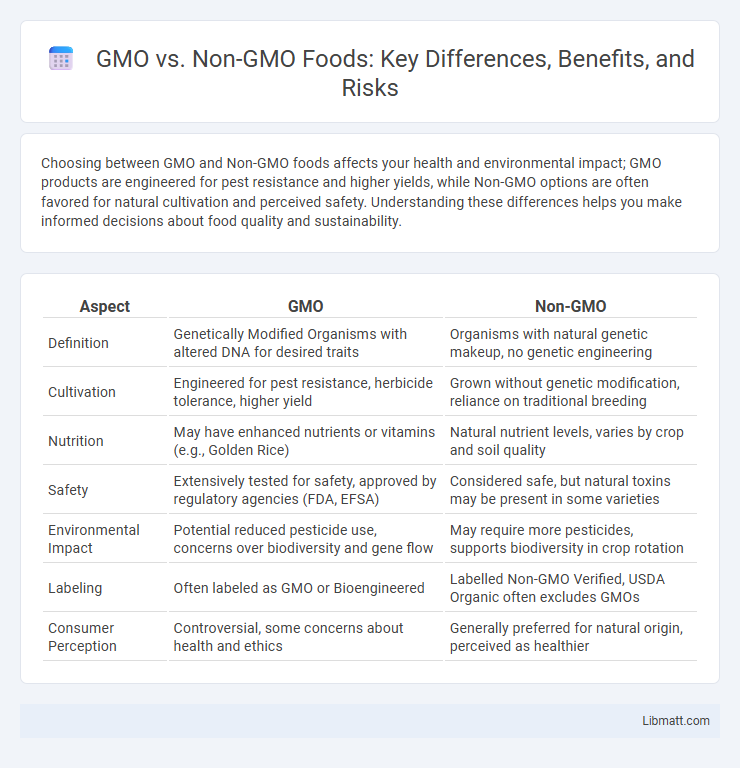Choosing between GMO and Non-GMO foods affects your health and environmental impact; GMO products are engineered for pest resistance and higher yields, while Non-GMO options are often favored for natural cultivation and perceived safety. Understanding these differences helps you make informed decisions about food quality and sustainability.
Table of Comparison
| Aspect | GMO | Non-GMO |
|---|---|---|
| Definition | Genetically Modified Organisms with altered DNA for desired traits | Organisms with natural genetic makeup, no genetic engineering |
| Cultivation | Engineered for pest resistance, herbicide tolerance, higher yield | Grown without genetic modification, reliance on traditional breeding |
| Nutrition | May have enhanced nutrients or vitamins (e.g., Golden Rice) | Natural nutrient levels, varies by crop and soil quality |
| Safety | Extensively tested for safety, approved by regulatory agencies (FDA, EFSA) | Considered safe, but natural toxins may be present in some varieties |
| Environmental Impact | Potential reduced pesticide use, concerns over biodiversity and gene flow | May require more pesticides, supports biodiversity in crop rotation |
| Labeling | Often labeled as GMO or Bioengineered | Labelled Non-GMO Verified, USDA Organic often excludes GMOs |
| Consumer Perception | Controversial, some concerns about health and ethics | Generally preferred for natural origin, perceived as healthier |
Introduction to GMOs and Non-GMOs
Genetically Modified Organisms (GMOs) are plants or animals whose DNA has been altered using genetic engineering techniques to enhance specific traits such as pest resistance or increased yield. Non-GMO products come from organisms that have not undergone genetic modification and are often preferred by consumers seeking natural or organic options. Understanding the differences between GMO and Non-GMO foods helps you make informed choices about nutrition, safety, and environmental impact.
Defining Genetic Modification
Genetic modification involves altering an organism's DNA to introduce new traits, such as pest resistance or enhanced nutrition, which distinguishes GMO crops from Non-GMO varieties grown through traditional breeding techniques. GMOs undergo precise gene editing, enabling improvements that cannot be achieved through conventional methods, often resulting in increased yield and environmental resilience. Understanding this fundamental difference helps you make informed choices about food safety, sustainability, and agricultural innovation.
Key Differences Between GMO and Non-GMO Foods
GMO foods contain genetically modified organisms engineered for traits like pest resistance or enhanced nutrition, whereas Non-GMO foods are grown without genetic alterations, relying on natural plant breeding. GMO crops often yield higher production rates and may require fewer pesticides, while Non-GMO foods appeal to consumers seeking natural or organic options. Understanding these key differences helps you make informed choices about health, environmental impact, and food quality.
Environmental Impact of GMO vs Non-GMO
GMO crops often require fewer chemical inputs like pesticides and herbicides, reducing soil and water contamination compared to non-GMO agriculture. Non-GMO farming typically relies on traditional practices that may lead to higher land use and increased greenhouse gas emissions due to lower crop yields. Understanding the environmental benefits of GMO can help you make informed choices about sustainable agriculture.
Health Implications: GMO vs Non-GMO
Scientific studies evaluating the health implications of GMO versus non-GMO foods have shown no conclusive evidence that genetically modified organisms pose greater health risks than their non-GMO counterparts. GMO crops undergo rigorous safety assessments by regulatory agencies like the FDA, EFSA, and WHO to ensure they do not introduce allergens or toxins harmful to humans. Your dietary choices might depend on factors beyond health, as both GMO and non-GMO foods generally meet safety standards established by global health authorities.
Economic Effects on Farmers and Consumers
GMO crops often offer farmers higher yields and reduced pesticide costs, enhancing overall farm profitability compared to non-GMO varieties. Consumers may benefit from lower prices due to increased production efficiency, though concerns about market monopolies and seed patenting can impact small-scale farmers financially. Your decision to choose between GMO and non-GMO products influences both agricultural sustainability and economic outcomes within global food markets.
Regulatory Standards and Labeling Practices
Regulatory standards for GMO and non-GMO products vary significantly by country, with agencies like the FDA in the United States requiring rigorous safety assessments for GMOs before market approval. Labeling practices differ as well, where non-GMO products often voluntarily display certifications such as the Non-GMO Project Verified label, while mandated GMO labeling is enforced in regions like the European Union. Understanding these regulatory frameworks and labeling conventions helps you make informed choices about the food you purchase.
Common Myths and Misconceptions
Common myths about GMO foods include beliefs that they cause allergies or are unsafe for human consumption, despite extensive scientific studies confirming their safety. Another misconception is that GMO crops harm the environment more than non-GMO varieties, but research shows they can reduce pesticide use and enhance sustainable farming practices. Non-GMO foods are often perceived as healthier, though nutritional differences are minimal and largely depend on specific crop varieties rather than genetic modification.
Consumer Choice and Market Trends
Consumer choice between GMO and non-GMO products is increasingly driven by health concerns, environmental impact, and ethical considerations, influencing market demand. Non-GMO product sales continue to rise as more consumers seek transparency and natural options, prompting retailers and producers to adapt their offerings. Your preferences shape market trends, pushing for stricter labeling standards and expanding availability in mainstream outlets.
Future Perspectives on GMO and Non-GMO Agriculture
Future perspectives on GMO and Non-GMO agriculture hinge on advancements in gene-editing technologies and consumer demand for sustainable practices. CRISPR and other precise genetic tools promise crops with improved yield, pest resistance, and climate resilience, while Non-GMO farming emphasizes biodiversity, organic methods, and natural ecosystem balance. Your choice between these agricultural approaches will influence food security, environmental impact, and market trends as innovation and regulation evolve.
GMO vs Non-GMO Infographic

 libmatt.com
libmatt.com